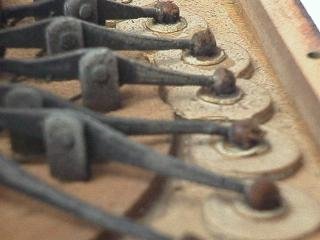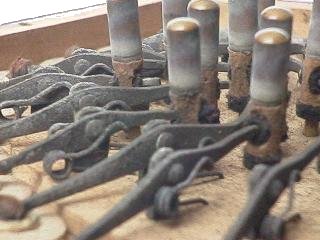|
The Action and
Pads

This
is the typical condition of concertina pads in older instruments. At first sight
it just looks dirty,
but when you examine the pads more closely, you'll notice
the felt is partly deteriorated.
A pad consists of a card board, felt and leather sandwich. The (leather) disk,
on top of the pad, is
connected to the leather bead, which is screwed on the
(brass) arm.
The bead/disk connection is flexible and adjusts the seating of the pad.
The oxidation on the riveted brass action (this is a Wheatstone) will interfere
with movement of the
lever.

Left
old, right new pad. Notice the difference in size. The felt in the old pad has
deteriorated.
You can even see a hole in the side. Sometimes you can spot worn
pads without having to open
the instrument by checking the key height. Uneven
key height can be a sign of deteriorated pads.

This is a view of the same instrument, but with new pads and oxidation free
action.
A 48 key concertina has the same number of pads, varying in size from about 11
mm for the high
notes to 24 mm or more for the lowest notes, depending on the
type of instrument.
The lower the note, the bigger the air hole needs to be to supply enough air.
The amount of travel
of the key when it is pushed down, determines how high the
pad will lift of the board. If the key travel
is too little, the reeds
(especially the lower ones) will not get enough air to vibrate fully. As a
result the
reed will be slow to speak and will have little or no harmonic
spectrum.

This
view shows the action, springs and keys with the (black) key base circle and
peg hole bushings.
Springs used to be made out of brass.
In this picture you can clearly see the oxidation on the springs. Old springs
can create a lot of problems.
Because brass looses its strength, brass springs
can easily break, causing a note to constantly sound.
In this instrument all the bushing and springs will have to be replaced, and the
action and keys polished.

This
shows the finished action. Although we sometimes still use brass for our
springs, we prefer steel.
The advantage of steel springs is that you can adjust the key pressure much more
accurate. They will
also keep the pressure constant much longer.
The height of the keys has a lot of influence on the sound quality of the
instrument. When the reeds
get the air they need, even brass reeds can sound
loud and and fast.
We set our action to 60-70 grams of key pressure and key travel somewhere
between 3.2mm and 4.0 mm,
depending make, age and type of concertina.
Rebuilding an action on a standard 48 key English means in parts: 48 pads, 48
springs, 48 leather beads
and disks, 48 key hole bushings, 48 peg hole bushings,
96 key base circles. All parts have to be hand made,
to the original
specifications.
Back
|